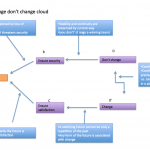We were invited by Pekka A. Viljakainen, author of ‘No Fear’, a book that addresses managing and leading a new generation of post-digital talent, how we would go about driving out fear from the workplace. The following posts are our response on achieving No Fear through a systemic organizational design and management methodology. Digital […]
Why change? Part 2
In Part 2 we look at how cause-and-effect reasoning and acknowledging our ‘cognitive constraints’ are crucial in understanding why, when, what and how to change. Dr. W. Edwards Deming used to warn about the consequences (cause and effect) of seemingly simple actions: “if we kick a dog in the street, we are responsible for the […]
Why Change? Part 1
In our previous post we looked at tools for the three phases of change (What to Change, What to Change to and How to Make the Change Happen). This post is in response to several comments that asked about the ‘why’ of change. Dr. W. Edwards Deming used to say: “The only thing that does […]
Change: Tools for Thinking, Planning and Enacting Change
Continuing our series on Change. In our previous post, we mentioned the three phases of change: what to change what to change to how to make the change happen For each of these phases, there is a powerful Thinking Process Tool from the Theory of Constraints (TOC). Let’s look at the three phases. What to […]
Change: Intuition, Understanding and Knowledge
Continuing our series on change. We live in an extraordinarily complex, post-digital world, where interdependencies and interconnections multiply at an ever-increasing speed. The cause-effect relationships that govern the world as we experience it create a super intricate ‘network of networks’ and we have a very limited understanding of the underlying properties of these networks and […]
Change: Control vs. Vision in our decisions to change
Change: Why do people find it so hard (and what can we do about it)?
In our next few posts we will be looking at the difficulty we have to change, and how we can achieve change and improve our systemic intelligence. Change is the most unchanging part of our existence: • our pancreas replaces most of its cells every 24 hours • the cells of our stomach lining are […]
Network of Networks (continued): The Intrinsic Risk of Super Hubs
When an enterprise is successful and grows in size, there is inevitably an increase in the number and quality of interdependencies, i.e. exchanges with other parts of the network of enterprises it is part of. These can include information, money, manpower, and goods etc. This leads to a double level of complexity: one level is […]
Skills vs. Culture – a Conflict in Education and Innovation
Humanity evolves through cooperation. This cognitive evolution has allowed us to grow beyond living in isolated, warring tribes to create international communities based on common interests. The distinctive feature that has allowed mankind to evolve in this cooperative way beyond animals is language. It is through language that humans create higher levels of consciousness. Thanks […]
Looking at the Core Conflict in Education and Innovation Today
In this post we will be looking at what we consider to be the Core Conflict regarding Education and Innovation. We have analyzed this conflict using a rigorous tool that combines intuition with logical analysis to produce a solution that is a non-linear synthesis. This Thinking Process Tool is known as the Core Conflict Cloud […]












